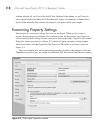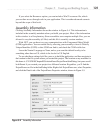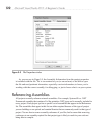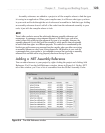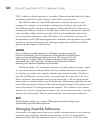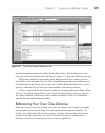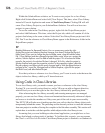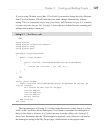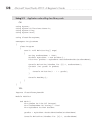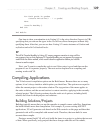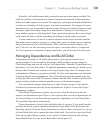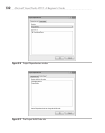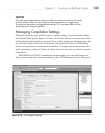
126 Microsoft Visual Studio 2010: A Beginner’s Guide
Within the SolutionDemo solution, we’ll create a new project for a class library.
Right-click SolutionDemo and select Add | New Project. This time, select Class Library
instead of Console Application and name it ClassLibraryDemo. Clicking OK will add
a new Class Library Project to your SolutionDemo Solution. You will now have two
projects in your solution.
To use the code in the ClassLibrary project, right-click the ProjectDemo project
and select Add Reference. This time, select the Project tab, which will contain all of the
projects that belong to the same solution. Select the ClassLibraryDemo project and click
OK. You’ll see the reference to ClassLibraryDemo appear in the References folder in the
ProjectDemo project.
TIP
Resetting References for Renamed Projects. You can rename any project by right-
clicking the project and selecting Rename. However, that doesn’t change the physical
folder name. If you want to change the physical folder name, close the solution (select
File | Close Solution) and then change the project folder name. When you re-open the
solution, Solution Explorer won’t be able to load the project. This is because the folder
name for the project in the solution file hasn’t changed. To fix this, select the project in
Solution Explorer and open the properties window. In the properties window, select the
file path property and either type the newly changed path or click the ellipses button to
navigate to the *.csproj file. Navigate back to Solution Explorer, right-click the project
that didn’t load, and select Reload Project.
Now that you have a reference to a class library, you’ll want to write code that uses the
objects in the class library, which you’ll learn about next.
Using Code in Class Libraries
To use class library code, you need to ensure you have a reference to the class library.
If using C#, you can add a using directive, and in VB you can add an Imports directive,
which allows you to use the types in the class library without fully qualifying them.
After referencing the class library assembly and ensuring namespaces are managed
properly, you can use class library classes and instantiate these externally referenced objects
and access or invoke the members as if they were part of the code in your own assembly.
The .NET CLR will take care of making sure that your calls to the class library object work
transparently behind the scenes. The preceding section showed you how to create the reference
from one project to another, allowing the compiler to find the other assembly. This section will
explain how to write the code that specifies which objects in the class library to use.
Assuming that you were building an educational application, you might have a class
library that helped you keep track of students. To facilitate this scenario, you can rename
the Class1.cs or Class1.vb file in the ClassLibraryDemo project to Student.cs or Student.vb.



